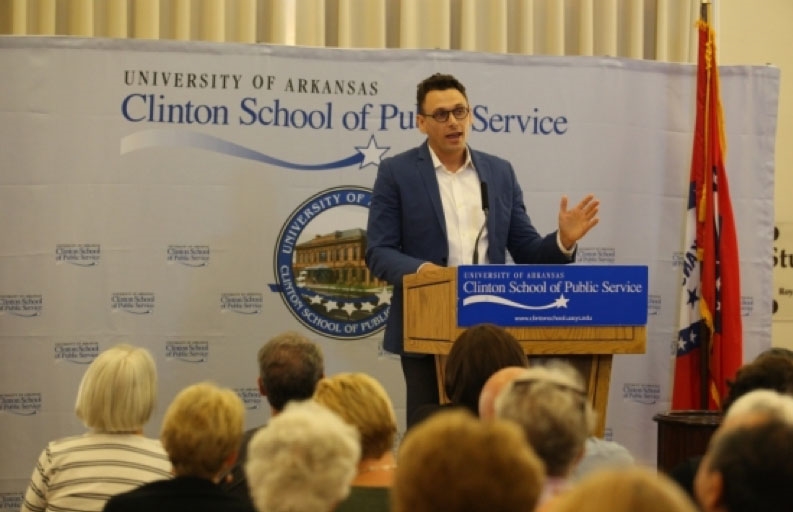
The Pryor Center Presents lecture series given by the The David and Barbara Pryor Center for Arkansas Oral and Visual History in the J. William Fulbright College of Arts and Sciences continues at 6 p.m. Thursday, Nov. 14, with "Climate, Design, and the Green New Deal," featuring Billy Fleming, the Wilks Family Director for the Ian L. McHarg Center at the University of Pennsylvania Stuart Weitzman School of Design.
Fleming's work is focused on the intersection of science, politics and design as they pertain to climate change. His recent research has focused on the use of nature-based strategies in climate adaptation planning along the American Coast.
Fleming says that the U.N. Intergovernmental Panel on Climate Change warns us that to avoid catastrophe, human societies have 12 years to wholly transform the way we consume food, energy, water and land, making changes on a scale for which there is no documented historic precedent.
As the Green New Deal surges to the forefront of the public imagination, the long-sought fusion of green- and blue-collar workers finally seems within reach. While considerable attention has been paid to the role of industrial and national economic policy in framing the Green New Deal thus far, little, if any, thought has been given to the ways in which it could transform the nation's sprawling built environment. And yet, it is a set of ideas and goals that will be understood through the buildings, landscapes, infrastructure and public works projects it delivers — and it is the only idea in contemporary American politics scaled to the challenges of climate change.
Fleming earned a Master of Community and Regional Planning from the University of Texas at Austin and a Bachelor of Landscape Architecture from the University of Arkansas, where he served as student government president for the state's lone research university. He was a 2011 University Olmsted Scholar. Fleming earned his Ph.D. in City and Regional Planning from PennDesign in 2017.
Upcoming Pryor Center Events
Nov. 1 – Performance by Like Butta'
Like Butta', a trio made up of Morty and Melody Mortenson and Jim Jernigan, plays an eclectic blend of Americana music including some jazz, R&B and international folk tunes dated from 1855 to today.
Nov. 6 – Pryor Center Presents Kevin Strait — "A People's Journey: Curating African American History and Culture in a National Museum "
Strait's talk will focus on the curatorial aspects of museum work, providing insight into specific acquisitions, objects and stories, and the creation of the Smithsonian's National Museum of African American History and Culture
Dec. 11 – Pryor Center Presents George Sabo — "Excavation in the Backyard of the Crescent Hotel"
Sabo, director of the Arkansas Archeological Survey, will talk about the excavation of artifacts behind the Crescent Hotel in Eureka Springs.
The Pryor Center is located at 1 East Center Street, Suite 120, and parking is available on the Fayetteville Square. The events are free and open to the public. Go to the center's website at pryorcenter.uark.edu to add our events calendar to yours.
About the David and Barbara Pryor Center for Arkansas Oral and Visual History: The David and Barbara Pryor Center for Arkansas Oral and Visual History is an oral history program with the mission to document the history of Arkansas through the collection of spoken memories and visual records, preserve the collection in perpetuity, and connect Arkansans and the world to the collection through the Internet, TV broadcasts, educational programs, and other means. The Pryor Center records audio and video interviews about Arkansas history and culture, collects other organizations' recordings, organizes these recordings into an archive, and provides public access to the archive, primarily through the website at pryorcenter.uark.edu. The Pryor Center is the state's only oral and visual history program with a statewide, seventy-five county mission to collect, preserve, and share audio and moving image recordings of Arkansas history.
About the J. William Fulbright College of Arts and Sciences: The J. William Fulbright College of Arts and Sciences is the largest and most academically diverse unit on campus with three schools, 16 departments and 43 academic programs and research centers. The college provides the core curriculum for all University of Arkansas students and is named for J. William Fulbright, former university president and longtime U.S. senator.
About the University of Arkansas: The University of Arkansas provides an internationally competitive education for undergraduate and graduate students in more than 200 academic programs. The university contributes new knowledge, economic development, basic and applied research, and creative activity while also providing service to academic and professional disciplines. The Carnegie Foundation classifies the University of Arkansas among only 2 percent of universities in America that have the highest level of research activity. U.S. News & World Report ranks the University of Arkansas among its top American public research universities. Founded in 1871, the University of Arkansas comprises 10 colleges and schools and maintains a low student-to-faculty ratio that promotes personal attention and close mentoring.
Topics
Contacts
William Schwab, executive director
Pryor Center
479-575-6829, bschwab@uark.edu
Andra Parrish Liwag, director of communications
J. William Fulbright College of Arts and Sciences
479-575-4393, liwag@uark.edu